Well known for its guitar amp simulators, Line 6 has recently updated its Toneport range of audio interfaces, and renamed it POD Studio while they were at it. Let's take a look at the new UX2 and see what changes have been made.
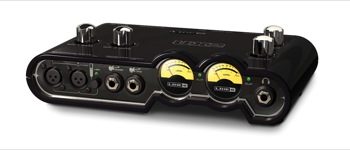 |
At around $200, there are many interfaces that are likely to attract beginner home-studio owners. Brands like PreSonus, M-Audio, Lexicon, E-MU, Alesis, Tascam, and Novation usually offer more or less the same thing, technically speaking, both in terms of features and quality. Within this context, Line 6 was able to differentiate itself with its Toneport range, whose success was based on its look, and especially the promise of giving access to the POD’s famous amp modeling through GearBox software. You never change a winning combination, so after a few variations of this basic concept (See the test of the UX-8), the time was ripe to update the TonePort GX, UX1, UX2, which were renamed for the occasion to POD Studio GX, UX1 and UX2. The difference between these respective models remains the same: POD Studio GX is geared at guitarists and/or bassists with only one instrument input, while the UX1 and UX2, which also have mic inputs, are designed to be more general purpose devices and therefore target home-studios. The UX1 is a product that could interest tight budgets (around $150) but which would soon show its limitations, since it only has one microphone input, which in addition doesn’t have phantom power (forget about stereo micing, and especially forget about using condenser mics). For this test, we’ll be taking a look at the UX2, which is much more comprehensive and sold at the very aggressive price of $190.
Same Concept
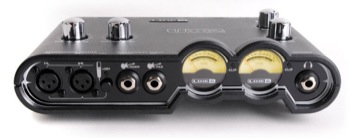 |
The least that can be said about the UX2 is that owners of the TonePort will feel right at home with this new version. Line 6 has indeed made very few changes to the design of the interface. Except for the fact that the red plastic hull has been replaced with a black plastic one, which makes it look more austere and modern, it has the same controls and the same connectors in the same places, not to mention the same printing on the hull. And this is a good thing too, because the UX2 is very well designed and is very user-friendly, even for beginners.
On the front panel there are two XLR mic inputs (combo inputs would have been better, but this isn’t such a big deal in light of the price of the UX) with a switch and a green LED that enables/disables the phantom power supply common to both inputs. Next to that are two 1/4-inch instrument inputs: one normal and one with a pad in order to be able to connect any guitar or bass, be it passive or active.
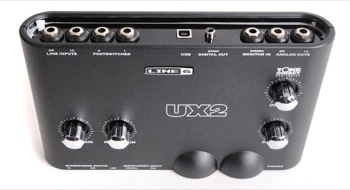 |
On the right side of the front panel, there’s a headphone output but also two large VU meters, kind of retro-analog style, indicating the level of the signal. Though they may not be extremely accurate, they’re handy because they’re easily readable while recording, and because there’s also a LED that alerts you of any possible digital clipping. One has to admit that Line6 has made more efforts than many of its competitors in the same price range as far as signal monitoring goes. This is especially true since the meters are also assignable via the included software: you can therefore monitor any input or output of the UX2 according to your needs. Plus, the orange lighting and the two dials give the UX2 a pretty cool look…
Let’s take a look at the back panel where there are 2 mono line-level inputs, a 1/4-inch stereo monitor input (this lets you listen to a line-level source without recording the signal) and two line outputs for connecting the interface to your monitor, all in 1/4-inch Jack format. Is that all? No, because in addition to the USB connector used to power the interface, there’s still an RCA S/PDIF connector and two 1/4-inch Jack inputs for two on/off type footswitches. Unfortunately, you can’t connect an expression pedal to the UX-2 …
On the top of the interface there are four knobs, two of which adjust the gain of each microphone preamp and two for adjusting the output level and the headphone level. In short, though there’s absolutely nothing new compared to the TonePort UX2, the POD Studio UX2 still has the merit of being rather comprehensive and user-friendly for beginners.
Plug and POD
|
As usual with devices by Line 6, installation is done through Line 6 Monkey, a software platform that manages all the licenses you have acquired and the updates for all of your products, from drivers to firmware, as well as updates to its amp simulation software. Keeping you 'up-to-date is its priority…
We won’t linger on the audio specs of the device since the POD Studio UX2 does nothing new, as I said, compared to the TonePort. Is this a problem? Not really, if you consider that the interface is very stable, it can work with reduced latency and its preamps and converters are quite good for this price range. There’s nothing to say about it then, and it seems almost a shame, because Line 6 could have taken the opportunity to correct some of the flaws of the previous version: rather than have two inputs for on/off type pedals, it would have been nice to include an input for expression pedals like the KB37, especially since the lack of MIDI connections prevents you from using more sophisticated pedals. Lastly, it would have also been nice if Line 6 had used metal instead of plastic for the hull, just so we could lug it around more safely. But for the price, we won’t be too picky, especially since its main interest lies elsewhere …
Old Macdonald had a POD
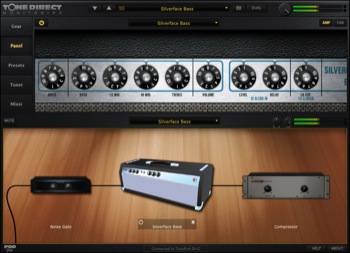 |
The real new feature here is the amp simulation software, since old GearBox has retired to make way for the new POD Farm, which, like its predecessor, is available in standalone or as a VST, AU, or RTAS plug-in. And it’s a good thing too, because Line 6 has really overhauled its software in an attempt to put it at the same level as its competitors’ software.
The most important change lies in the new 'dual’ mode feature that now gives you not one, but two available effects chains, offering interesting possibilities: getting two different sounds on the left and the right, mixing two amps together, or simultaneously processing vocals and guitar (note that despite the two instrument inputs on the front panel, you can only use one of them at a time, so, for example, it’s not possible to simultaneously process a bass and guitar). It’s definitely a long ways away from from the split signal and overlapping channel possibilities available in a program like Guitar Rig, but it’s not bad at all …
Graphically, the software has also changed enormously. It seems bigger and the interface is now more streamlined. You choose elements via the Gear tab and an iTunes-like browser, with nice 3D representations: double click on a model or simply drag & drop to place it in a chain below … The menu bar, which isn’t as nice looking but perhaps more efficient, organizes all gear by categories (Guitar Amps, Bass Amps, Preamps, Distortion), so it is really easy to navigate. By using the 'Panel’ tab (which also has reworked graphics that are very nice to use), you can access the settings for each component of the effects chain.
Room For Improvement
In spite of numerous strong points, POD Farm is far from perfect and retains some of Gearbox’s annoying defects, such as the inexplicable absence, in the plug-in version, of the very practical tuner found in the Standalone version … But the main shortcoming of the software, compared to its competitors, comes mainly from the non-flexibility of the effects chains that you can build. The number of elements and their placement have limitations and it’s impossible, for example, to chain 4 delays or 4 amps together just to see what it’s like, or put a distortion pedal behind a reverb. Of course, these kinds of experiments are more for sound design than anything else, and the limits posed by Line 6, while making the software easier to understand (night and day compared to the complexity of ReValver) already offer numerous possibilities. Still, you could eventually start to feel a little limited …
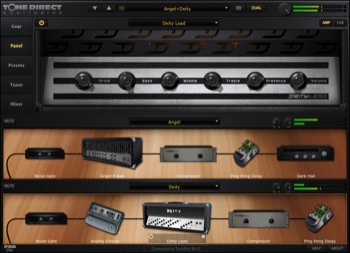 |
It should be mentioned that the sounds produced by the software which, not surprisingly, are the same found in Line 6's POD, are good as long as you know what to expect. What does this mean? That POD Farm’s sounds have a ready to use and mix aspect to them that should please beginners in search of classic tones without the hassle. But, purists looking for the response and feel of a real amp will probably be frustrated by Line 6's algorithms which tend to gloss over many nuances (especially with distorted sounds). So, it would probably be better for them to take a look at Amplitube or Softube and Overloud plug-ins which are more faithful on this point … Anyway, you can rest assured that once within a mix, guitars recorded with POD Farm will pull off the illusion perfectly and it’s no coincidence that Line 6's red rack is present in most studios on the planet. Therefore it’s a good tool, despite a few small shortcomings, and plays a big part in the POD Studio’s quality/price ratio …
An interesting detail is that Pod Farm is not the only software included with the UX2. The bundle also includes a version of Ableton’s Live 6, which, despite limitations on the number of tracks, number of plug-ins, or audio formats, still includes 28 effects, and the instruments Simpler and Impulse. There’s also Reason Adapted which, even though it has a reduced bank of sounds, less instruments, and fixed chaining (which prevents it from reading projects made with the full version of Reason), still retains some interesting features, including Subtractor and especially Malström which remains one of the most famous granular synths. Lastly there’s the freeware version of RiffWorks T4 which is a sort of notepad for guitarist that’s well thought out and allows collaborative work via the Internet, but unfortunately, in this version, is deprived of certain essential functions of the full version: exporting to WAV format for example … Be that as it may, there’s more than enough software included to get you started and it you’ll have to admit that, though it’s not as rich as the bundles included with E-MU interfaces, it easily outclasses the competition in this price range, which usually offers a Cubase LE flanked by a bunch of freeware.
Conclusion
Even if it doesn’t really change much on the hardware side compared to the TonePort, the POD Studio UX2 interface remains, for around $190, one of the best gear choices a beginner could make, provided he/she doesn’t need a MIDI connection. It’s stable, efficient, and easy to use and has one of the best software bundles in this price range, thanks to the presence of POD Farm which makes it particularly attractive for guitarists.
- Ease of use.
- Stability.
- GearBox changing to POD Farm.
- POD Farm, Live Lite, and Reason Adapted: a generous bundle.
- Excellent value for money.
- POD Farm’s lack of flexibility.
- No MIDI connection.
- Plastic hull.
